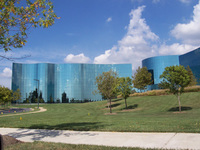JHU Life Sciences Center: show me the transit!
Johns Hopkins University wants to expand and update its Shady Grove Life Sciences Center to meet the needs of the 21st Century. JHU owns the 100-acre Belward Farm in West Gaithersburg, and Montgomery County is developing a plan for the area. It aims to change the campus from its current form as a “sprawling, single-use, auto-oriented area” to a place that can be “more vibrant, dynamic, and walkable with a physical form that is as inspiring as the discoveries that are going on inside the labs and classrooms throughout the area.” It could achieve that vision if the planned Corridor Cities Transitway actually reaches the site. If not, it’ll be just 100 acres of VMT-inducing office park.
Johns Hopkins is competing with every other university in the world for top research talent. They believe that the upcoming generation of talent does not want to be in a wind-swept suburban office park. In order to be competitive, their facilities must have a sense of place. Otherwise, a candidate will be happy to go another university that is in a more dynamic, urban environment. The University of Maryland feels similarly.
The neighbors around Belward Farm site are pushing for a more “reasonable” approach. While they echo the usual concerns about reducing density, lowering building heights, and reducing cars and traffic, their tactics are very different from other neighbor opposition like the
Kensington Heights townhouses
. The neighbors aren’t pushing for a moratorium on all development. There is no cynical application to include Belward Farm as a part of the Legacy Open Space Program.Currently, the plans call for a Corridor Cities Transitway station on the site in the future. The danger is that this development could still happen without the transit. While Kentlands is a wonderful New Urbanist development, it is missing one key ingredient: transit. Its lack of transit prevents its economic systems from acting more like Bethesda or Silver Spring. Despite its urban form, it functions more like a subdivision bedroom community.
Unlike Bethesda, Silver Spring, Wheaton, Columbia Heights, Dupont Circle, Pentagon City, and Ballston, few people come from other communities to patronize the businesses in Kentlands. Consequently, like a local strip mall, it can only support local-serving businesses. Its residents also must drive to work or to regional retail centers, or deal with inconvenient, infrequent bus service. That doesn’t mean Kentlands was a bad idea. But its current lack access to quality transit is keeping from reaching its potential as a dynamic, truly sustainable place.
It is very challenging to plan a place that connects with a rail line that is still in the preliminary planning stages. Everyone in our region would lose if the Johns Hopkins University Life Sciences Center expands in a transit-oriented walkable urban form without any transit. And unfortunately, Montgomery County has a history of this occurring, with BRT-oriented development around Olney.
Human scale, walkable urban development is great, but, its place matters. Just as no man is an island, no place is an island. Any new piece of development requires some sort of infrastructure link. Out society now has a decades-old precedent of building the default link in the form of asphalt and rubber. Just like in Olney, without proper planning for a station on the CCT, the Johns Hopkins University Life Sciences Center will be stuck in the same limbo as Kentlands, National Harbor, and Reston Town Center: wasted potential.
Without transit, Johns Hopkins will not get their desired vibrant walkable urban world-class research environment. It will be less desirable for outside investment. Our region will not see as much economic activity as if the Life Sciences Center was directly connected to the National Institutes of Health by rail. More importantly, the development will only increase, rather than reduce, carbon emissions from personal automobile trips to and from the facility.
Ideally, JHU would build right next to NIH at the Medical Center Metro instead of out at the edge of our region’s developed area. However, JHU already owns the land on the current site and they already have some facilities there. They’re intent on expanding their research facilities, which earn them a lot of money. They currently have a suburban car-dependent office park that could not integrate with transit even if it were available. While this plan is not perfect, it is better than what already exists.
The stakes are high on this project and its connectivity with the CCT. If executed successfully, it will connect our entire region with another world-class life sciences research facility. Our region will gain another regional serving center for economic and social vitality. If it fails, though, we will only have yet another paved over 107-acre parcel, and a lot of unmet potential.

